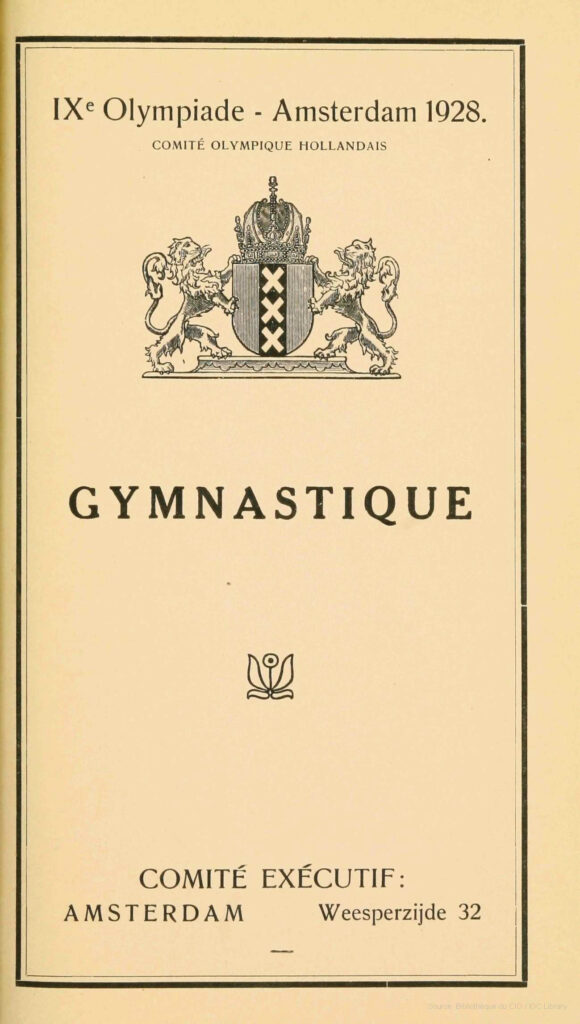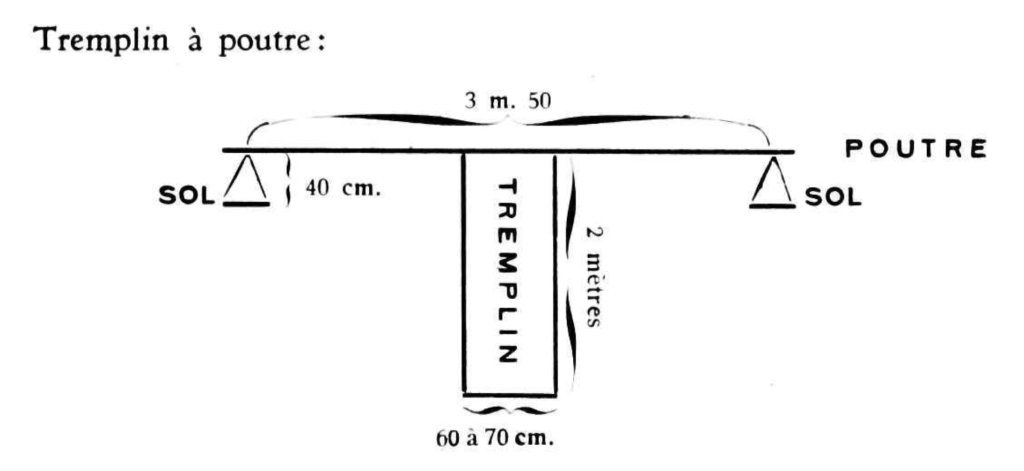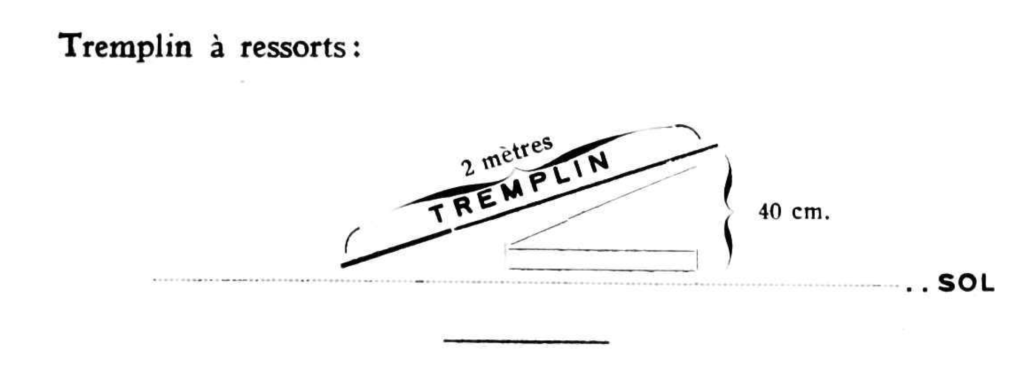At the Olympic Games prior to 1928, the men competed in track and field events, rope climbing, or even an obstacle course (1920).
The Amsterdam Olympics marked a turning point in men’s gymnastics. For the first time, the athletes competed only on gymnastics apparatus at the Olympic Games. No rope climb. No sprints. No high jump. Just apparatus gymnastics.
However, the Olympic program still hadn’t taken its modern form. In 1928, male gymnasts didn’t perform individual floor routines. They did, however, perform on the floor as an ensemble, and, as we’ll discuss in the next post, the Yugoslav team had a remarkable ensemble routine.

Team Structure
A team of 8 men (or 7) per nation, who will take part in all the events. To determine the final result, the scores of the best six competitors will be taken into account. The two (or the only) gymnasts who obtain the least amount of points will be eliminated.
The reserves will therefore take part in all exercises and will participate also in the individual rankings.
Note: In other words, the team score wasn’t based on the top 6 scores on each event. Rather, it was based on the top six all-around scores for each country’s gymnasts.
The Events
Ensemble:
Free exercises executed by each nation.
Apparatus:
A compulsory and optional exercise on high bar, parallel bars, pommel horse, and rings.
Vaults:
- A compulsory vault on a horse with pommels and “tremplin dur” of 10 cm in height in front;
- An optional vault on a long horse without pommels and a “tremplin à poutre” (board on a beam) or “tremplin à ressorts” (spring board); height of the horse is 1.40 cm above the board.
Note: Gymnasts had to touch one or two hands for the optional vault.
Additional Guidance on Routines
Ensemble Routine:
Free exercices. Each nation performs ensemble floor routines together for 10 to 12 minutes. Every nation is entirely free in the choice and composition of its free exercises. This performance includes marches and patterns and preliminary exercises following the method of every nation.
Compulsory and optional routines must differ:
The optional exercise must be different from gymnast to gymnast on the same team.
Compulsory routines can be repeated for the best score.
On the apparatus, any gymnast can restart a compulsory exercise or compulsory vault only once, the best execution of which will be taken into consideration. The optional exercises can be executed only once and will be judged decisively.
Note: In other words, a gymnast could see his score before deciding whether to perform the compulsory routine again.
Scoring of the Routines
Ensemble Routines
There will be 5 judges, of different nationalities if possible, who will award a maximum of 50 points, multiplied by the coefficient 6 — 300 points.
The distribution of the judgment is the following.
1. Individual execution. 2 judges at 20 points where the average = 20 points
2. Combination and difficulty. 2 judges at 20 points where the average = 20 points
3. Execution of the ensemble. 1 judge at 10 points.
Total = 50 points
The duration of a performance will be a minimum of 10 minutes and a maximum of 12 minutes. In the case of a performance that lasts shorter or longer than the prescribed time, there will be a reduction of 10 points on the overall result obtained in this performance.
Apparatus Routines
Each exercise will be judged by 3 (three) judges each awarding 10 points maximum; so that for each exercise there may be awarded 30 points.
Vaults
Each vault will be judged by 3 (three) judges awarding each 10 points maximum and the total thus obtained will be divided by 2, so that, for each vault, 15 points can be awarded.
In other words, there were 60 points possible for each apparatus: high bar, parallel bars, pommel horse, and rings. Meanwhile, vault counted for only 30 points total, and the vault score was the average of the compulsory and optional vaults.
When you add it all up…
Total possible points for the team: 1,920
Total possible points in the individual all-around: 270 points
Apparatus Norms
Teams could bring their own apparatus:
Each nation is authorized to use for the contests its own apparatus, which will be transported and installed at its own risk and perils and its costs.
Horizontal Bar
| Dimension | 1924 | 1928 | 1948 | 2021 |
| Diameter | 32 mm | 28.5 mm | 28/30 mm | 28 mm |
| Height | 230 cm | “Swing Height” | 240 cm | 280 cm |
Additional Notes in 1928: Polished steel; length 2.40 m.
Parallel Bars
| Dimension | 1924 | 1928 | 1948 | 2021 |
| Height | 150 cm | 165 cm “Shoulder Height” | 160 cm | 200 cm |
| Width | 42 cm | 42 cm | 42 to 46 cm | 42 to 52 cm |
| Length | 280 cm | 300 cm | 300 to 360 cm | 350 cm |
Additional notes in 1928: Oval-shaped bar 46 x 54 mm.
Rings
| Dimension | 1924 | 1928 | 1948 | 2021 |
| Height of Portico | N.S. | 550 cm | 550 cm | 580 cm+ |
| Height of Rings from Floor | 230 cm | 250 cm | 240 cm | 280 cm |
| Inner Diameter of Rings | 17.5 cm | 18 cm | 18 cm | 18 cm |
| Thickness | 22 or 23 mm | 28 mm | 28 mm | 28 mm |
Pommel Horse
| Dimension | 1924 | 1928 | 1948 | 2021 |
| Height of Horse | 160 cm | 180 cm | 180 cm | 190 cm |
| Width of Horse | 40 cm | 35 cm | 35 to 37 cm | 35 cm |
| Spacing of Pommels | 42 cm | 39 to 42 cm | 42 cm | 40 to 45 cm |
| Height to Top of Pommels from Floor | 140 cm | 120 cm | 120 cm | 127 cm |
| Height of Pommels from Horse | NS | 12 cm | 12 cm | 12 cm |
Vault
Compulsory vault with pommels: “tremplin dur,” 10 cm high, in front, placed 1 meter in front of the horse, measuring from the middle of the horse
Height of the horse: 1.30 m from the floor to the top of the pommels.
Optional vault — long horse without pommels: The horse had to be 1.40 m from the top of the board.
The gymnasts had two options for boards during the optional vault. Option 1:

Option 2:

For more information about these boards, head over to this post.
Additional Rules
There were also rules about team directors, injuries, attire, and more.
Each competing team will be under the direction of a non-ranking director, throughout the duration of the events. The duties of the Director will be limited to leading the section before the Jury and from one event to another; he will be able to show the ensemble exercises, on one side, and will direct them. Before the execution of the routines, the Director must check that the apparatus are in good condition; during the execution, he must stand close to the apparatus to possibly prevent an accident, but cannot help in performing an exercise. His names and title will be mentioned on the list of names of the gymnasts forming the section. His work is neither evaluated nor scored. He will be the intermediary between the Jury and team.
The order of the competing teams will be indicated by the drawing of lots.
A schedule will be established, according to which the groups will line up for the competitions.
At the time indicated for the beginning of the events, all the members of the Jury and the competing teams must be on the ground at the designated locations.
Groups arrive and depart altogether.
Members of the jury are obliged to be at their events and cannot accept functions that could distance them from the field of play and thus hinder the regular progress of the competition.
Any gymnast leaving his team without authorization from the Jury can’t return.
It is not permitted during the course of events to substitute one gymnast for another.
Gymnasts must take into account the observations of the Jury.
Any indisposition, any accident, must be immediately reported by the Director and observed by the doctor on duty.
In order to allow the indisposed gymnast to recover, he or his team may interrupt his work for twenty minutes at most. If, after this period of time, the incapacity observed persists, the team will resume work, and the gymnast will be eliminated.
Any complaint concerning the participation of a gymnast must be made at the start of the competition, or as soon as the cause arises.
Competition attire must be uniform for all gymnasts of a team; members of the same team will wear a common distinctive insignia. Gymnasts specifically cannot take off their shoes.
The field for the events will be fully isolated and accessible only to members of the Jury, gymnasts, and Directors of the competing teams.